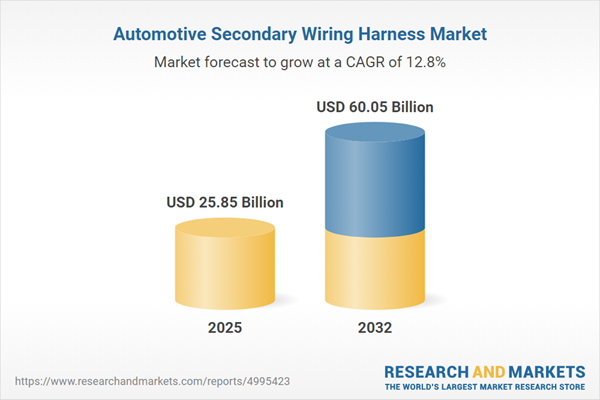Speak directly to the analyst to clarify any post sales queries you may have.
The automotive secondary wiring harness market is evolving rapidly as the shift to connected, electric, and autonomous vehicle technologies reshapes both the supply chain and competitive strategies. Senior leaders must anticipate new integration, regulatory, and resilience challenges to capture evolving opportunities in this dynamic environment.
Market Snapshot: Accelerated Growth in Secondary Wiring Harness Demand
The automotive secondary wiring harness market grew from USD 22.88 billion in 2024 to USD 25.85 billion in 2025. With a projected CAGR of 12.81%, the sector is expected to reach USD 60.05 billion by 2032. Rising adoption of electrified drivetrains, complex ADAS applications, and upgraded infotainment systems is significantly boosting harness demand across all major automotive segments. Tighter emissions standards and consumer demand for advanced in-vehicle experiences drive requirements for lighter, modular, and high-data-capacity wiring architectures.
Scope & Segmentation of the Automotive Secondary Wiring Harness Market
- Vehicle Types: Heavy commercial vehicles, light commercial vehicles, passenger cars
- Application Areas: Body electronics (comfort and convenience, lighting), chassis (braking, steering and suspension), infotainment (audio, navigation, telematics), powertrain (engine management, transmission control), safety and security (ADAS, airbag)
- Insulation Materials: PVC, XLPE
- Conductor Materials: Aluminum, copper
- End Use: Aftermarket, original equipment
- Regions: Americas (North America: United States, Canada, Mexico; Latin America: Brazil, Argentina, Chile, Colombia, Peru), Europe, Middle East & Africa (Europe: United Kingdom, Germany, France, Russia, Italy, Spain, Netherlands, Sweden, Poland, Switzerland; Middle East: United Arab Emirates, Saudi Arabia, Qatar, Turkey, Israel; Africa: South Africa, Nigeria, Egypt, Kenya), Asia-Pacific (China, India, Japan, Australia, South Korea, Indonesia, Thailand, Malaysia, Singapore, Taiwan)
- Leading Companies: Yazaki Corporation, Sumitomo Wiring Systems Ltd., Aptiv PLC, Leoni AG, Lear Corporation, TE Connectivity Ltd., Furukawa Electric Co. Ltd., Nexans SA, Fujikura Ltd., LS Cable & System Ltd.
Key Takeaways for Senior Decision-Makers
- The automotive secondary wiring harness market is vital for advanced connectivity and electrification, serving as the essential pathway for next-generation mobility features.
- Material innovation and digital diagnostics are rapidly redefining harness performance expectations, as OEMs demand durable, lightweight, and intelligent modules integrated with real-time monitoring capabilities.
- Global suppliers are increasingly adopting modular design, recyclable materials, and simulation-driven engineering to improve sustainability and system performance.
- Intensifying regulatory and consumer demands necessitate agile production, end-to-end quality assurance, and investment in digital platforms for predictive maintenance and diagnostics.
- Leading industry participants are strengthening competitiveness by forming strategic alliances—particularly in insulation technology and diagnostic module integration—to address both regulatory and functional requirements.
- Segment differentiation remains crucial as commercial and passenger vehicle harnesses require distinct approaches to balance performance, routing, and repairability. Market leaders are leveraging this by tailoring innovations for each category.
Tariff Impact: Navigating Supply Chain Disruptions
New United States tariffs introduced in 2025 have increased the complexity of global supply chains in the secondary wiring harness sector. Key component costs have risen, leading OEMs and suppliers to reassess sourcing strategies and accelerate localization. Stakeholders are exploring alternative material choices and near-shoring facilities to mitigate cost pressures, while maintaining rigorous quality standards. These shifts encourage closer collaboration across the supply chain and open avenues for agile participants to gain market share by delivering cost-optimized, resilient solutions.
Methodology & Data Sources
This report uses a multi-phase research approach, combining secondary research from industry publications, patents, and financial disclosures with primary insights from interviews with OEMs, suppliers, and material experts. Data triangulation and scenario analysis validate performance and supply chain findings, ensuring reliability. A dedicated team enforces quality assurance throughout the research process.
Why This Report Matters
- Enables C-suite and strategy leaders to make informed investment decisions by illustrating key shifts in technology, regulations, and supply chain dynamics.
- Outlines critical segmentation and regional growth factors, supporting market entry or expansion planning across global automotive hubs.
- Delivers actionable recommendations on risk mitigation, material innovation, and digital capability deployment to maintain long-term market relevance.
Conclusion
Mastering the evolving secondary wiring harness market requires a holistic view of technology, regulation, and regional opportunities. By acting on the insights in this report, stakeholders can position themselves for sustained value creation and leadership.
Additional Product Information:
- Purchase of this report includes 1 year online access with quarterly updates.
- This report can be updated on request. Please contact our Customer Experience team using the Ask a Question widget on our website.
Table of Contents
3. Executive Summary
4. Market Overview
7. Cumulative Impact of Artificial Intelligence 2025
Companies Mentioned
The companies profiled in this Automotive Secondary Wiring Harness market report include:- Yazaki Corporation
- Sumitomo Wiring Systems, Ltd.
- Aptiv PLC
- Leoni AG
- Lear Corporation
- TE Connectivity Ltd.
- Furukawa Electric Co., Ltd.
- Nexans SA
- Fujikura Ltd.
- LS Cable & System Ltd.
Table Information
| Report Attribute | Details |
|---|---|
| No. of Pages | 185 |
| Published | October 2025 |
| Forecast Period | 2025 - 2032 |
| Estimated Market Value ( USD | $ 25.85 Billion |
| Forecasted Market Value ( USD | $ 60.05 Billion |
| Compound Annual Growth Rate | 12.8% |
| Regions Covered | Global |
| No. of Companies Mentioned | 11 |









